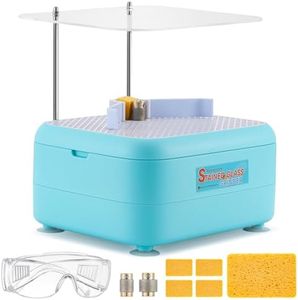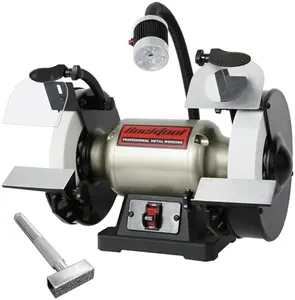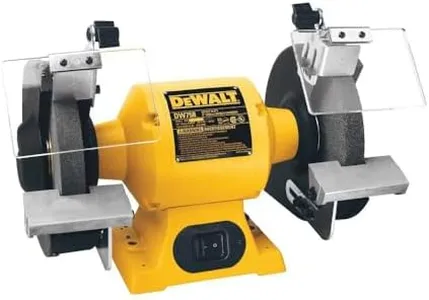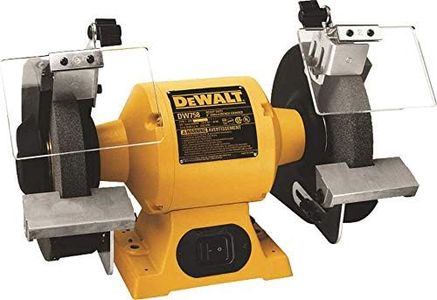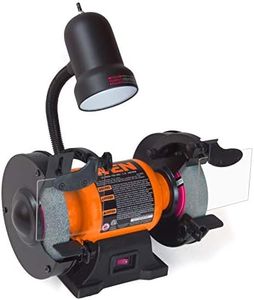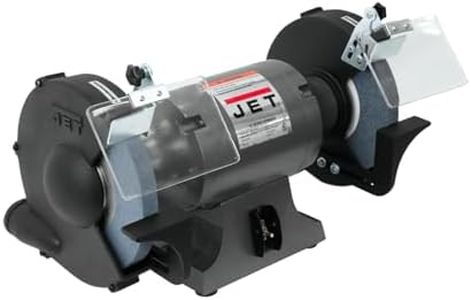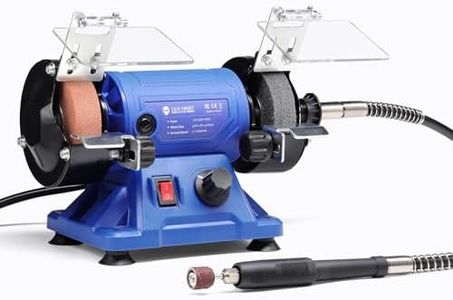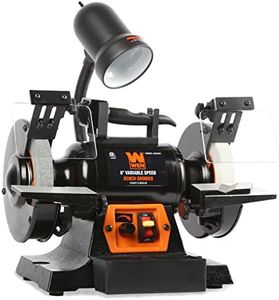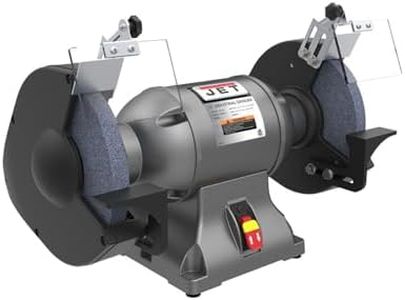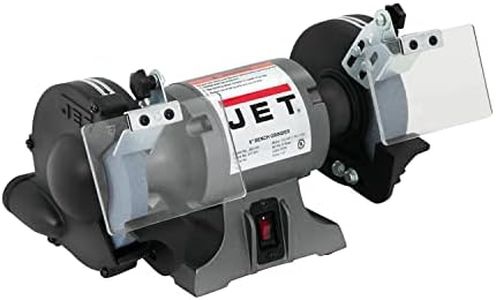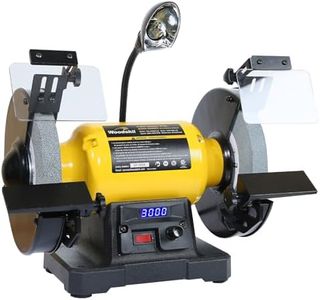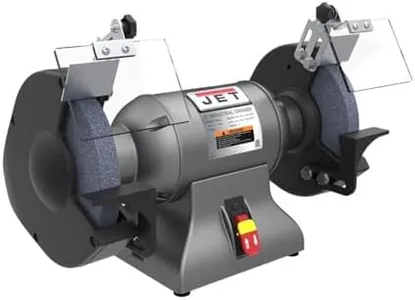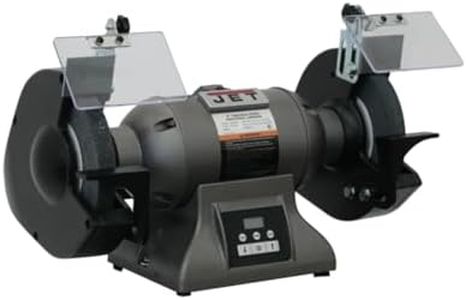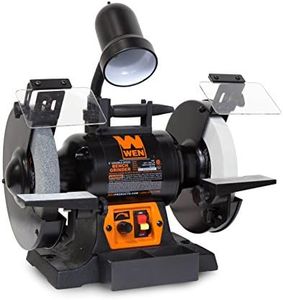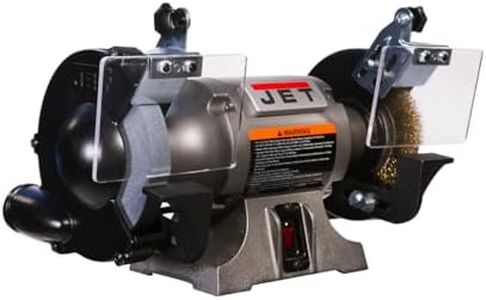10 Best Bench Grinders 2025 in the United States
Our technology thoroughly searches through the online shopping world, reviewing hundreds of sites. We then process and analyze this information, updating in real-time to bring you the latest top-rated products. This way, you always get the best and most current options available.

Our Top Picks
Winner
BUCKTOOL 8 Inch 3/4 HP Low-Speed Bench Grinder fit CBN Wheel Professional Wobble-free Wheel Grinder TDS-200C4HL
Most important from
529 reviews
The BUCKTOOL 8 Inch 3/4 HP Low-Speed Bench Grinder is a solid choice for professional use, particularly for carpenters, turners, and carvers. One of its standout features is the powerful motor with a low-speed of 1750 RPM, which ensures smooth and efficient grinding. The motor’s 3/4 HP rating can handle tough tasks, and the peak power of 1-1/4 HP is capable of driving the CBN wheel effectively. The grinder includes two different grit wheels (80 grit and 120 grit), providing versatility for various sharpening tasks.
The extra-wide 1-1/2 inch WA grinding wheel is particularly beneficial for more extensive and detailed work. The added LED light with an individual switch is a nice touch for precision tasks, and the angle-adjustable eye shield with magnification improves safety and accuracy. The cast iron base with rubber feet helps in reducing vibrations, providing a stable work environment. Additionally, the cast aluminum tool rest, adjustable from 0 to 45 degrees, adds to the ease of use and precision.
On the downside, the grinder weighs 46 pounds, which might make it less portable for some users. The inclusion of safety features like a safety switch with a key to prevent unauthorized operation adds to its appeal for professional use.
Most important from
529 reviews
DEWALT DW758 8-Inch Bench Grinder
Most important from
2502 reviews
The DEWALT DW758 8-Inch Bench Grinder is a solid choice for those in need of a powerful and durable bench grinder. With a 3/4 HP induction motor, it provides robust power suited for industrial grinding applications. The 8-inch wheel size and 3,600 RPM motor speed allow for efficient material removal, making it suitable for heavy-duty tasks.
The grinder's rugged cast iron base and motor housing ensure longevity and stability during operation, which is important for maintaining precision over time. Users will appreciate the precision-machined aluminum tool rests that facilitate accurate positioning of workpieces, enhancing the quality of the grinding results. Additionally, the inclusion of eye shields and spark deflectors boosts safety during use. The rear exhaust ports in the wheel guards help in smoother operation by reducing dust accumulation, though it's worth noting the grinder does not have a dedicated dust collection system, which might be a consideration for those with stricter cleanliness requirements.
The substantial 12-1/2-inch distance between the wheels makes this grinder suitable for handling larger and longer grinding projects, adding to its versatility. It is relatively heavy (0.22 kilograms or approximately 7.7 ounces) due to its cast iron construction, which could make portability a challenge. This bench grinder does not include batteries, as it is corded electric, and it operates quietly, adding to user comfort. The product dimensions are 17.75 inches in length, 12.63 inches in width, and 11.73 inches in height. Included in the package are a 60 grit wheel, 36 grit wheel, eye shields, spark deflectors, and tool rests. The DEWALT DW758 is a reliable option for users requiring a heavy-duty, long-lasting bench grinder for industrial or extensive home improvement tasks.
Most important from
2502 reviews
DEWALT 6 Inch Bench Grinder, 3,450 RPM (DW756)
Most important from
1758 reviews
The DEWALT 6 Inch Bench Grinder (DW756) is a robust tool designed for heavy-duty grinding tasks. It features a powerful 5/8 HP induction motor that delivers high-speed material removal at 3,450 RPM, making it suitable for a variety of grinding applications. The industrial cast iron base and motor housing provide durability, ensuring the grinder can withstand frequent use over time.
The precision-machined aluminum tool rests enable users to position their work accurately, which is crucial for achieving precise results. Additionally, the rear exhaust ports in the wheel guards help maintain smooth operation by directing debris away from the work area. The 12-1/2-inch distance between the wheels allows for grinding larger items with ease.
However, it's worth noting that this bench grinder does not come with a dust collection system, which might be a drawback for those concerned with maintaining a clean workspace. The grinder's corded electric power source ensures consistent performance, but it also means that mobility is limited to the availability of power outlets. With an impressive customer rating of 4.8 out of 5 stars from 1,734 reviews, it's clear that many users are satisfied with its performance. The DEWALT DW756 is best suited for those in need of a reliable and durable bench grinder for both home and industrial use.
Most important from
1758 reviews
Buying Guide for the Best Bench Grinders
When choosing a bench grinder, it's important to consider your specific needs and the tasks you plan to perform. Bench grinders are versatile tools used for sharpening, shaping, and polishing metal and other materials. Understanding the key specifications will help you select the best bench grinder for your workshop or garage.FAQ
Most Popular Categories Right Now
